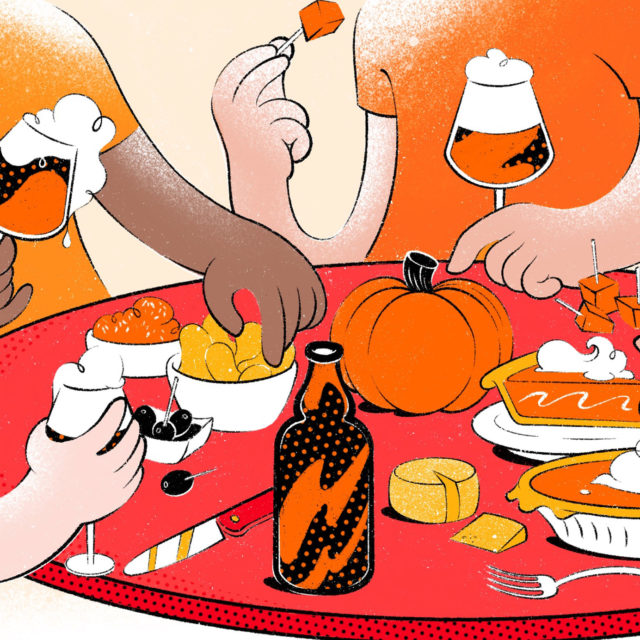Around Halloween, North America’s craft beer scene turns its focus to pumpkin beer, a seasonal offering with a love-it-or-hate-it nature: Of all beer styles, as Clay Risen wrote in The Atlantic, “none is more divisive than pumpkin ales.”
Even if pumpkin beer isn’t your personal favorite, you probably have a clear idea of what it is — well, as long as you’re from the U.S. or Canada. After all, both countries eat pumpkin pie at Thanksgiving. Both are well stocked with lattes, muffins, and other doses of “pumpkin spice” at local Starbucks and Tim Hortons.
This makes perfect sense when you consider history and geography. The field pumpkin, a.k.a. Cucurbita pepo, is actually native to the Americas, where it has been used in brewing beer since at least 1771. But as craft beer expands around the world, drinkers who are completely unfamiliar with pumpkin pie, pumpkin spice, and even jack-o’-lanterns are getting a chance to sample their first pumpkin ales.
Sometimes, it doesn’t work out perfectly. And in other cases, that means making a very different kind of pumpkin beer.
At Germany’s Orcabrau brewery, founder Felix vom Endt learned about pumpkin beers while working at a brewery and a liquor store while living on Canada’s west coast.
“People got really crazy about pumpkin beers when the season arrived,” vom Endt says. “They were calling and asking, ‘When are the pumpkin beers going to arrive?’ And then the shelves were full of pumpkin beer. The shelves were full of pumpkins, pumpkin pies, pumpkin muffins — everywhere pumpkin, pumpkin, pumpkin.”
Inspired by the tastes he’d encountered in Vancouver and Seattle, vom Endt decided to make his own pumpkin brew, Big Mama, when he launched Orcabrau after he returned home to Nuremberg. Despite the fact that it used pumpkins from the brewery’s home region of Franconia, Big Mama faced an uphill battle from local beer lovers.
“We put it on sale, and no one was really interested in it. People were saying, ‘What? Pumpkin in a beer! This is not working!’” vom Endt recalls. “I thought it would be easy to hook up the Franconians on the pumpkin because it is locally grown, but people were a bit skeptical. It was hard to get them to even try the beer.”
At Poland’s Browar Kingpin, brewery owner Marek Kamiński decided to take a different approach when he created his pumpkin ale, Muerto.
“I have the impression that most pumpkin beers are spiced quite heavily, and I have an impression that pumpkin beers are associated with the spices, not with the pumpkin,” Kamiński says. “So we decided to brew it without spices.”
Made with small Hokkaido pumpkins sourced from a local farm, Kingpin’s Muerto was fermented with a Belgian ale yeast and brewed with an addition of sea buckthorn.
“We used it to have something else in our beer, to give it a fruity, tart flavor to counter the pumpkin sweetness. So it was not a traditional pumpkin beer as you know it — no spices,” Kamiński says. “It was a pumpkin ale, but done in a completely different way.”
Other brewers around the world produce pumpkin beers with their own local connections. Japan’s Baird Beer makes its Country Girl ale with kabocha, a species of winter squash that often appears in Japanese tempura. In the Piedmont region of Italy, Birra Baladin created its Zucca ale to celebrate the annual pumpkin festival in its hometown of Piozzo. In the Italian province of Latina, south of Rome, Birrificio Pontino brews its Orange Poison, an “Italian pumpkin ale,” adding the syrupy mix of candied fruits known as mostarda di frutta, as well as actual mustard and black pepper, before “dry-hopping” the beer with bitter almonds and nutmeg to create amaretto-like flavors.
On the other side of Italy, close to Venice, Birrificio Artigianale Veneziano brews its Pimpi, which brewmaster Dario Bona describes as simple and easy-drinking. “We don’t use any spices at all — it’s all about pumpkin for us,” Bona says. “We brew a simple Scotch ale, with a hint of peated malt. Then we add pumpkin puree in the fermentation tank, like a dry hopping.”
In Kyiv, Ukraine, Varvar Brew has created pumpkin beers in a number of styles. While the brewery has used pumpkin-pie spices for some of those brews, Varvar spokesperson Lana Svitankova notes that those spices aren’t necessarily local tastes.
“Today people mostly consider cinnamon, ginger, nutmeg, and maybe cloves as ‘pumpkin spice,’ but I think this is a concept borrowed from American tradition,” Svitankova says, noting that the brewery is taking a different tack for its upcoming pumpkin beer. “This year it will be an imperial stout with super-sweet baked pumpkin and no spice at all.”
In the end, pumpkin ales seem like much of the rest of North American craft beer culture: easily transportable to other places around the world, where the style can once again be made into something new. In many ways, it might be easier to create a unique take on pumpkin beer in a place where pumpkin doesn’t automatically bring to mind the mandatory additions of ginger, cinnamon, nutmeg, cloves, and allspice. As Kingpin’s Kamiński explains, brewing a pumpkin beer in Poland meant that he had a relatively clean slate.
“At that time, and I have the impression even now, there were not so many pumpkin beers in Poland,” Kamiński says. “Pumpkin pie is not that popular in Poland.”
